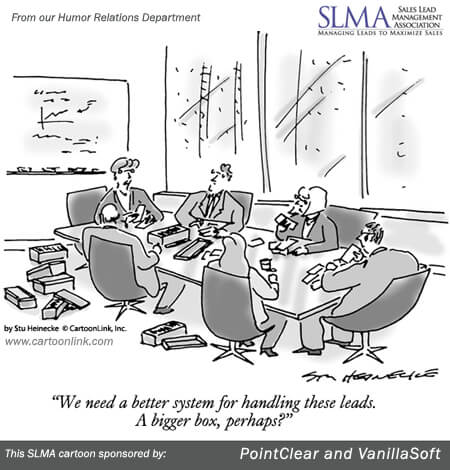
The Sales Lead Management Association has launched a cartoon series focused on lead management software. VanillaSoft got the opportunity to sponsor the first cartoon and we jumped on it. Sometimes, a cartoon can capture in a single frame what bloggers and experts try to share with thousands of words. The first cartoon really got me thinking; is a bigger box the answer?  For the good folks sitting at our table, the answer is clearly no.
For the good folks sitting at our table, the answer is clearly no.
However, don’t be surprised at the number of businesses who get lost when trying to figure out how to better manage their leads, their sales people and their opportunities. As a 30 year veteran of the space, I actually remember when a bigger box may have been the next logical step. Today, however, there are endless vendors, platforms, systems and strategies vying for your attention. The question today is which box, or which system, is the right fit for your needs.
As much as you need a strategy to manage your leads, people and sales, you also need a strategy to select the right technology and the best vendor to deploy the technology you have selected. With so many choices competing for your attention getting to the heart of the matter becomes challenging. In past posts, I outlined some thoughts and questions that seem relevant to our cartoon and your journey if you need a bigger box or new system.
Q 1: What is your desired end state? Visibility/better lead management or more production from sales?
If it is a production boost you are seeking, I would shy away from traditional CRM and seek out platforms that increase the effectiveness of your sales team through enablers that power and increase their activity. If your sales are fine and you are seeking a deeper understanding of the customer relationship, then CRM may hold the answer.
Q2: What is your bandwidth to implement a new platform?
If you are a small or medium sized company without an IT department, then simpler is better. CRM can be a bear to implement, especially if you are going to have several departments making multiple touches. Find out from the service providers the “time-to-implement” related cost and be sure to ask if they have a consulting group. If they do, they have it for a reason and it is usually not cheap. With today’s choices, there are platforms that can do amazingly complex tasks and provide real selling power, including dialing, but be up and running in hours, rather than weeks or days. If you do have an IT department, then work closely with them. Often times, if IT leads the charge, you will end up with a highly integrated and complex system, but with a platform that does little for the people doing the selling. Ensure that Sales leads the way on choice and functionality and let IT do the due diligence and implementation.
Q3: What is your budget?
Needless to say, budget will rule the day. The good news is that with the vast amount of offerings today, companies can pick from best-of-breed providers and power their Inside Sales people for cents per hour. Pricing is all over the place but you can start to get some real functionality starting at $65 per month and max out around infinity. SaaS providers can provide the best value. Choosing a SaaS provider means you do not need to budget for IT implementation cost, and you will always have the latest and greatest. In most cases a contract is not required.
Even if you have a big budget and an IT department to do the heavy lifting, don’t confuse more spent money and complex implementation with more productivity. Go back to Q1. What is your desired end state? Simpler is better if it gets you the desired results.
Q4: What is the cost of distractions?
Adding a new platform or changing platforms is not done in a vacuum. There will be lost productivity as team members migrate through the change. The most masterful implementations that I have seen always involved the selling team early in the process. Create buzz around the value to them. Explain how this will increase their sales, thus earning them more. Too often CRM looks more like Big Brother riding into to town to catch the wrongdoers instead of an enhancement and new asset for the sales staff. Although it may really be all about you or the company, make it all about them!
Q5: What if it all goes bad?
Don’t laugh. There are numerous white papers and case studies focusing on some of the largest companies in the word who got it wrong, spent millions trying to undo their decision only to find themselves being sucked down the vortex of bad decision/bad technology. My gut tells me that IT led the charge on those.
With all of the vendors with great offerings, easy implementation and no contracts, there is no reason to make a bad decision that you can’t turn around very quickly. Most service providers offer a free trial. You don’t have to go all in. Pick a vendor, pick a campaign and give them a try. Most will tell you in advance if they are a good fit for your sales organization. After all, they have a vested interest as well. Most include service as part of the monthly service charge. An unsatisfied and needy customer cuts into their margins. That, my friends, is bad for everyone.
In summary, if you are like the good folks in the cartoon, then at the very least you should know that bigger boxes come in all kinds of shapes and sizes. I promise there is one that is a near perfect fit for your budget and size. Make your list of the must have features and the nice to have features. Find a vendor that can deliver the entire list of must haves and as much of the nice to haves as possible. Try not to get distracted by the bells and whistles they want to talk about and demo, and stay the course on your needs.
Best,
Ken


